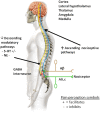Clinical experience with duloxetine in the management of chronic musculoskeletal pain. A focus on osteoarthritis of the knee
- PMID: 24294303
- PMCID: PMC3836379
- DOI: 10.1177/1759720X13508508
Clinical experience with duloxetine in the management of chronic musculoskeletal pain. A focus on osteoarthritis of the knee
Abstract
Duloxetine is a serotonin and norepinephrine reuptake inhibitor (SNRI) with central nervous system activity. Its analgesic efficacy in central pain is putatively related to its influence on descending inhibitory pain pathways. The analgesic efficacy of duloxetine has been demonstrated in four distinct chronic pain conditions. These include neuropathic pain associated with diabetic peripheral neuropathy, fibromyalgia, chronic low back pain, and osteoarthritis knee pain (OAKP). The purpose of this review is to examine the clinical efficacy and safety of duloxetine in the management of chronic OAKP. Three separate randomized, double-blind placebo-controlled trials have demonstrated that (1) a clinically meaningful decrease in pain severity occurs at about 4 weeks relative to placebo, (2) patients receiving duloxetine report better improvements in physical functioning relative to placebo, (3) duloxetine is safe and effective when used adjunctively with nonsteroidal anti-inflammatory drugs, and (4) that there are no new safety signals beyond what has been observed in other indications.
Keywords: Chronic pain management; drug interactions; duloxetine; osteoarthritis.
Conflict of interest statement
Figures

References
-
- Altman R., Asch E., Bloch D., Bole G., Borenstein D., Brandt K., et al. (1986) Development of criteria for the classification and reporting of osteoarthritis. Classification of osteoarthritis of the knee. Diagnostic and Therapeutic Criteria Committee of the American Rheumatism Association. Arthritis Rheum 29: 1039–1049 - PubMed
-
- American Academy of Orthopaedic Surgeons (2008) American Academy of Orthopaedic Surgeons clinical practice guideline on the treatment of osteoarthritis of the knee (non-arthroplasty). Rosemont, IL: American Academy of Orthopaedic
-
- Apkarian A., Bushnell M., Treede R., Zubieta J. (2005) Human brain mechanisms of pain perception and regulation in health and disease. Eur J Pain 9: 463–484 - PubMed
-
- Arnold L., Lu Y., Crofford L., Wohlreich M., Detke M., Iyengar S., et al. (2004) HMBO - A double-blind, multicenter trial comparing duloxetine with placebo in the treatment of fibromyalgia patients with or without major depressive disorder. Arthritis Rheum 50: 2974–2984 - PubMed
-
- Arnold L., Rosen A., Pritchett Y., D’Souza D., Goldstein D., Iyengar S., et al. (2005) HMCA - A randomized, double-blind, placebo-controlled trial of duloxetine in the treatment of women with fibromyalgia with or without major depressive disorder. Pain 119: 5–15 - PubMed
Publication types
LinkOut - more resources
Full Text Sources
Other Literature Sources
Medical

